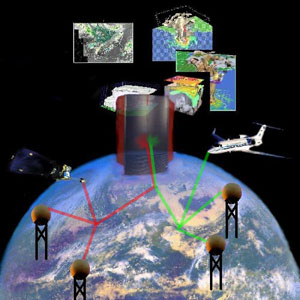Dangers of Volcanic Ash
Travel Safety Threat
Damage in Flight
Damage on the Ground
North Pacific Air
Travel
Ring of Fire
Volcano Ground Observatory
Aircraft/Pilot Limitations
Remote Sensing Detection
GOES-Visible/Thermal IR
NOAA-AVHRR
EOS AURA -MLS/TES/OMI
Monitoring
and Warning
ICAO
WMO/NOAA
VAAC
ATC
Air Carrier Operation
Flight Crew Advisories
METAR
PIREPS
SIGMETS
References
Home
|
|
Under the umbrella of the International
Civil Aviation Organization (ICAO),
the challe nge was quite complex but it could be done;
it involved integrating all of these valuable and numerous in shear
numbers of resource agencies. The potential threat that volcanic ash poses to commercial jet
aircraft ,however, merited bringing them together. Through ICAO, it
established a collaborative working network of experts sharing information; they
are government authorities, scientists, pilots,
airline dispatchers, volcanologists, meteorologists, air traffic
controllers and others that are all working towards this common objective of ensuring aviation
safety. According to an April 2000 Bulletin of the American
Meteorological Society, "these efforts have identified the need for
specialized air carrier operations, procedures, communications, routings,
and training ..." and to meet these operational needs of the industry, " a
number of government agencies have become involved in the issuance of
warnings, advisories, information, and flight adjustments". This report
focuses upon the major operational contact points in a very complex
communication network of interactions that provides for
commercial aviation safety; they are the nine Volcanic Ash Advisory Centers (VAACs), World
Meteorological Offices (such as NOAA
National Weather Service Aviation Weather Center ) , Air Traffic Control Centers, and
Air Carrier Operations. (What's nge was quite complex but it could be done;
it involved integrating all of these valuable and numerous in shear
numbers of resource agencies. The potential threat that volcanic ash poses to commercial jet
aircraft ,however, merited bringing them together. Through ICAO, it
established a collaborative working network of experts sharing information; they
are government authorities, scientists, pilots,
airline dispatchers, volcanologists, meteorologists, air traffic
controllers and others that are all working towards this common objective of ensuring aviation
safety. According to an April 2000 Bulletin of the American
Meteorological Society, "these efforts have identified the need for
specialized air carrier operations, procedures, communications, routings,
and training ..." and to meet these operational needs of the industry, " a
number of government agencies have become involved in the issuance of
warnings, advisories, information, and flight adjustments". This report
focuses upon the major operational contact points in a very complex
communication network of interactions that provides for
commercial aviation safety; they are the nine Volcanic Ash Advisory Centers (VAACs), World
Meteorological Offices (such as NOAA
National Weather Service Aviation Weather Center ) , Air Traffic Control Centers, and
Air Carrier Operations. (What's
 interesting about this image
above is that the VAAC organization does not provide complete world monitoring
as evidenced by the gaps present in their network.) interesting about this image
above is that the VAAC organization does not provide complete world monitoring
as evidenced by the gaps present in their network.)
The key to the success of commercial aviation safety is being able to provide time sensitive information to
pilots and air carrier operations centers of
current volcanic eruptions and of forecasted areas of volcanic activity.
The aviation industry requirement of "a warning system that strives
to provide a five-minute response time once an ash eruption has been
detected" according to an aircraft dispatcher for United Airlines, Leonard
Salinas.
Avoidance of volcanic ash encounters also helps save millions of dollars
in runaway
aircraft repair costs incurred as a direct result of volcanic ash
inflicted damage. |
 nge was quite complex but it could be done;
it involved integrating all of these valuable and numerous in shear
numbers of resource agencies. The potential threat that volcanic ash poses to commercial jet
aircraft ,however, merited bringing them together. Through ICAO, it
established a collaborative working network of experts sharing information; they
are government authorities, scientists, pilots,
airline dispatchers, volcanologists, meteorologists, air traffic
controllers and others that are all working towards this common objective of ensuring aviation
safety. According to an April 2000 Bulletin of the American
Meteorological Society, "these efforts have identified the need for
specialized air carrier operations, procedures, communications, routings,
and training ..." and to meet these operational needs of the industry, " a
number of government agencies have become involved in the issuance of
warnings, advisories, information, and flight adjustments". This report
focuses upon the major operational contact points in a very complex
communication network of interactions that provides for
commercial aviation safety; they are the nine Volcanic Ash Advisory Centers (
nge was quite complex but it could be done;
it involved integrating all of these valuable and numerous in shear
numbers of resource agencies. The potential threat that volcanic ash poses to commercial jet
aircraft ,however, merited bringing them together. Through ICAO, it
established a collaborative working network of experts sharing information; they
are government authorities, scientists, pilots,
airline dispatchers, volcanologists, meteorologists, air traffic
controllers and others that are all working towards this common objective of ensuring aviation
safety. According to an April 2000 Bulletin of the American
Meteorological Society, "these efforts have identified the need for
specialized air carrier operations, procedures, communications, routings,
and training ..." and to meet these operational needs of the industry, " a
number of government agencies have become involved in the issuance of
warnings, advisories, information, and flight adjustments". This report
focuses upon the major operational contact points in a very complex
communication network of interactions that provides for
commercial aviation safety; they are the nine Volcanic Ash Advisory Centers (